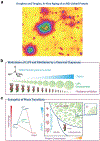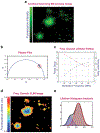Fluorescence Lifetime Imaging Microscopy of Biomolecular Condensates
- PMID: 36227471
- PMCID: PMC10321152
- DOI: 10.1007/978-1-0716-2663-4_6
Fluorescence Lifetime Imaging Microscopy of Biomolecular Condensates
Abstract
Biomolecular condensates of ribonucleoproteins (RNPs) such as the transactivation response element (TAR) DNA-binding protein 43 (TDP-43) arise from liquid-liquid phase separation (LLPS) and play vital roles in various biological processes including the formation-dissolution of stress granules (SGs). These condensates are thought to be directly linked to neurodegenerative diseases, providing a depot of aggregation-prone proteins and serving as a cauldron of protein aggregation and fibrillation. Despite recent research efforts, biochemical processes and rearrangements within biomolecular condensates that trigger subsequent protein misfolding and aggregation remain to be elucidated. Fluorescence lifetime imaging microscopy (FLIM) provides a minimally intrusive high-sensitivity and high-resolution imaging method to monitor in-droplet spatiotemporal changes that initiate and lead to protein aggregation. In this chapter, we describe a FLIM application for characterizing chemical chaperone-assisted decoupling of TDP-43 liquid-liquid phase separation and aggregation/fibrillation, highlighting potential therapeutic strategies to combat pathological RNP-associated aggregates without compromising cellular stress responses.
Keywords: Droplet maturation; Fluorescence lifetime imaging microscopy; Intrinsically disordered proteins; Liquid-liquid phase separation; Neurodegenerative diseases; Protein aggregation; TDP-43.
© 2023. The Author(s), under exclusive license to Springer Science+Business Media, LLC, part of Springer Nature.
Figures



References
-
- Sharma R, Choi KJ, Quan MD, Sharma S, Sankaran B, Park H, LaGrone A, Kim JJ, MacKenzie KR, Ferreon ACM, Kim C, Ferreon JC (2021) Liquid condensation of reprogramming factor KLF4 with DNA provides a mechanism for chromatin organization. Nat Commun 12 (1):5579. doi:10.1038/s41467-021-25761-7 - DOI - PMC - PubMed
Publication types
MeSH terms
Substances
Grants and funding
LinkOut - more resources
Full Text Sources

